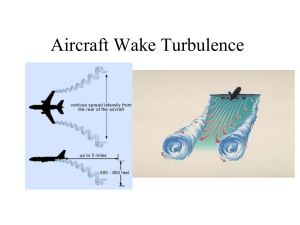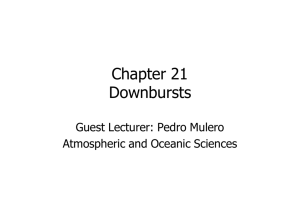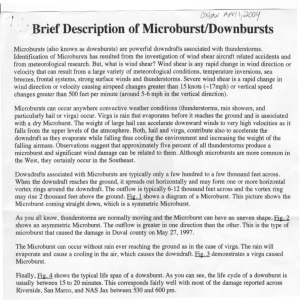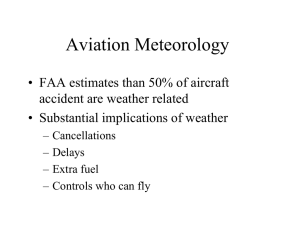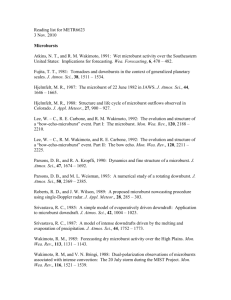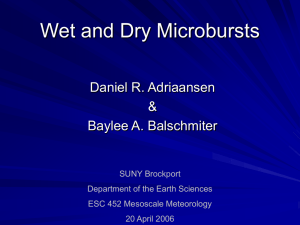Downbursts and dust storms
advertisement
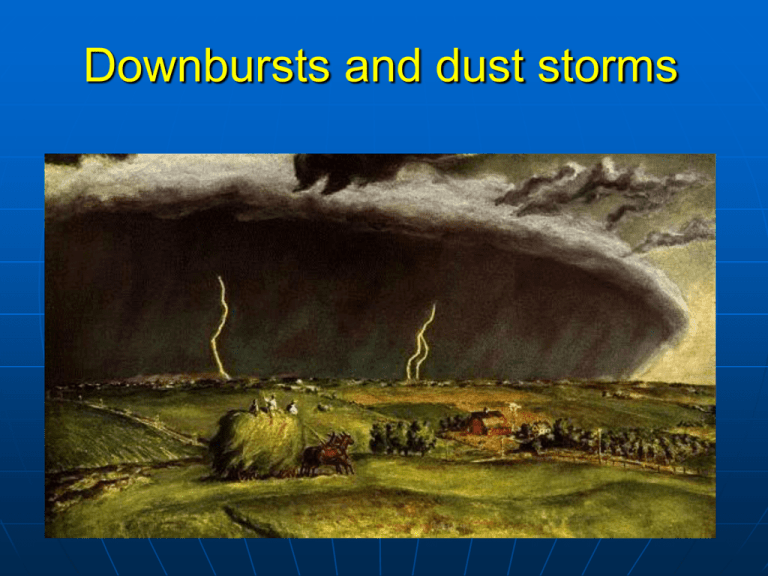
Downbursts and dust storms Review of last lecture 1. 2 types of mesoscale convective systems 2. Structure of MCCs 3. Structure of squall lines: four components 4. Derechos Downbursts: Introduction • Downbursts are gusts of wind that can reach speeds in excess of 270km/hr (165mph), and are potentially deadly. • Three common types: • Derechos (1000 km) • Haboobs (10-100 km) • Microbursts (1 km) Video: Microburst http://www.youtube.com/watch?v=NT3Ybu GHfC4 Microburst • is a very localized column of downdraft (sinking air) in a thunderstorm that is less than 2.5 miles in scale. • produces damaging divergent and straight-line winds at the surface as high as 150mph • is similar to, but distinguishable from, tornadoes, which generally have convergent damage. • can produce dangerous situations at airports, as they impede air travel. • 3 types: dry, wet, hybrid Development of microburst Three stages: Contact, Outburst, Cushion Structure of a microburst Dry microburst Very dry boundary layer topped by a moist layer Primarily driven by cooling beneath the thunderstorm cloud base due to rain evaporation and ice sublimation Little or no rain. Often associated with high-based thunderstorms. Sometimes associated with fair weather Dry microburst: visual identification Virga in the sky: defined as wisps or streaks of water or ice particles falling out of a cloud but evaporating before reaching the earth's surface as precipitation. (NOAA 2001) Blowing dust/dust rings at surface Very good indicators of dry microburst potential Wet microburst A nearly saturated layer topped by an elevated dry layer primarily driven by entrainment of mid-level dry air and precipitation loading. accompanied by heavy precipitation at the surface. Wet microburst: visual identification A rain foot may be a visible sign of a wet microburst. Fatal crashes or aircraft incidents due to microbursts A BOAC Canadair C-4 (G-ALHE), Kano Airport - 24 June 1956. A Malév Ilyushin Il-18 (HA-MOC), Copenhagen Airport – 28 August 1971. Eastern Air Lines Flight 66 Boeing 727-225(N8845E), John F. Kennedy International Airport – 24 June 1975 Pan Am Flight 759 Boeing 727-235 (N4737), New Orleans International Airport – 9 July 1982 Delta Air Lines Flight 191 Lockheed L-1011 TriStar (N726DA), Dallas/Fort Worth International Airport – 2 August 1985 Martinair Flight 495 McDonnell Douglas DC-10 (PH-MBN), Faro Airport – 21 December 1992 USAir Flight 1016 Douglas DC-9 (N954VJ), Charlotte/Douglas International Airport – 2 July 1994 Goodyear Blimp GZ-20A (N1A, "Stars and Stripes"), Coral Springs, Florida – 16 June 2005 Bhoja Air Flight 213 Boeing 737-200 (AP-BKC), Islamabad International Airport, Islamabad, Pakistan- April 20 2012 Causes of atmospheric turbulence 1. 2. 3. 4. Thermals - Heat from the sun makes warm air masses rise and cold ones sink. Jet streams - Fast, high-altitude air currents disturb the air nearby. Mountains - Air passes over mountains and causes wave and turbulence on the other side. Wake turbulence - Near the ground a passing plane or helicopter sets up small, chaotic air currents, or Microbursts – dry, wet and hybrid. Video: Haboobs http://www.youtube.com/watch?v=LGDvBk 4knF0 Haboobs • Very strong horizontal winds over desert regions create sandstorms called haboobs (from the Arabic word meaning “wind”). • Occur regularly in arid regions throughout the world. Global distribution of aerosols Global impact of dust storms Factors contributing to dust storms Desertification Drying of global soil moisture Desertification Caused mainly be human activities and climate change Is one of the most significant global environmental problems About a billion people are under threat Global desertification vulnerability Drying of global soil moisture PDSI: Palmer drought severity index Summary 1. 3 types of downbursts (derechos, haboobs, microbursts) 2. 3 types of microbursts (wet, dry, hybrid). 3. 4 causes of atmospheric turbulence. 4. Haboobs (dust storms). Global desertification. Drying of global soil moisture Works cited http://www-frd.fsl.noaa.gov/mab/microburst/ http://www.cimms.ou.edu/~doswell/microbursts/Handboo k.html
